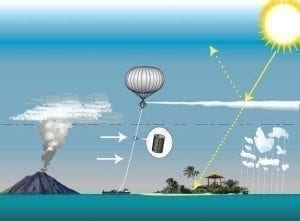Is geoengineering pure insanity? Maybe we should talk about it
 Is geoengineering the key to solving the global climate change problem? That’s the kind of question that evokes a knee-jerk reaction from those how consider it, including me. I believe we’re already doing enough geoengineering on the planet, albeit unplanned and perhaps unintended. For me, geoengineering like the kind environmental engineer David Keith speaks of in the TED Talk video below, is a fool’s errand.
Is geoengineering the key to solving the global climate change problem? That’s the kind of question that evokes a knee-jerk reaction from those how consider it, including me. I believe we’re already doing enough geoengineering on the planet, albeit unplanned and perhaps unintended. For me, geoengineering like the kind environmental engineer David Keith speaks of in the TED Talk video below, is a fool’s errand.
Keith, who has done extensive research into geoengineering, doesn’t necessarily disagree. But he does caution that to make an informed and morally justified decision about whether to employ it or not requires a more nuanced approach in how we think about it.
“Imagine space aliens… arrive and they give you a box. The box has two knobs. One is the knob for controlling global temperature and maybe the other knob is for controlling CO2 concentrations. You might imagine that we would fight wars over that box, because we have no way to agree where to set the knobs. Now I don’t think that’s going to happen, it’s not very likely. But we’re building the box. The scientists and engineers of the world are building it piece by piece… Even when they’re doing it for other reasons. Even when they think they’re just working on saving the environment. They have no crazy ideas like engineering the whole planet, they develop science that makes it easier to do.”
Even if Keith believes geoengineering is possible, he makes it clear where he stands on its value.
“And I guess my view on this is not that I want to do it – I do not. But that we should move it out of the shadows and talk about it seriously, because sooner or later we’ll be confronted with decisions about this and it’s better if we think hard about it even if we want to think hard about reasons why we should never do it.
We need a broader debate, a debate that includes musicians, scientists, philosophers, writers who get engaged with this question about science engineering and think seriously about what its implication are.”
One way Keith proposes we could think about geeengineering is that we should just forge ahead and do it instead of worrying so much about mitigating carbon emissions. He posits that the methods he and his colleagues have been studying could create a “new ice age” at the cost of “.001 percent of GDP, “it’s very very cheap, we have a lot of leverage.”
“It’s not a good idea,” Keith is quick to add, “but it’s just important to tell you how big the lever is, the lever is that big. That argument is not much in dispute,” Keith says. “You might argue about the sanity of it, but the leverage is real.”
So as emissions continue to accelerate in their rate of increase, we just increase in tandem the amount of geoengineering.
“I don’t think anybody takes that seriously,” says Keith, “because under this scenario we walk further and further away from the current climate. We have all sorts of other problems like ocean acidification that come from CO2 in the atmosphere anyway…”
“But here’s a case that’s harder to reject: let’s say that we don’t do geoengineering but we do what we ought to do which is get serious about cutting emissions. But we really don’t know about how quickly we have to cut them. There’s a lot of uncertainty about how much climate change is too much.”
Keith goes on to explain in this scenario that humanity does come around, not just “tapping” on the brakes, but we pushing hard to slow CO2 emissions, starting now.
“And then maybe someday like 2075… we finally reach that glorious day where concentrations have peaked and they’re rolling down the other side… we’ve seen the worst of it. But maybe on that day we see the Greenland ice sheet is melting unacceptably fast. Fast enough to put meters of sea level rise on the oceans in the next hundred years and remove some of the biggest cities from the map. That’s an absolutely possible scenario.. We might decide at the point that even if geoengineering was uncertain and morally unhappy, that’s it’s a lot better than not geoengineering. And that’s a very different way to look at the problem. It’s using this as risk control, not instead of action.”
But even if that scenario sounds acceptable to some, there’s still a problem, says Keith:
“Knowledge that geoengineering is possible makes the climate impact less fearsome, and that makes a weaker commitment to cutting emissions now.”
This leads to what economists call a “moral hazard,” Keith says.
“That’s one of the fundamental reasons why this topic is so hard to talk about. In general I think it’s the underlying reason why it’s been politically unacceptable to talk about this. But you don’t make good policy by hiding things in a drawer”
Keith therefore suggests an aggressive and comprehensive research program of geoengineering is vital. Not necessarily to promote the idea, but to fully understand it, though Keith expresses his doubt in getting past the moral hazard problem.
In the end, the more we take seriously the idea of geoengineering and try to understand it, even if to determine why it is such a bad idea, the better off we will be in the face of a changing climate. It sure beats a knee-jerk reaction.
Image credit: Wikipedia


